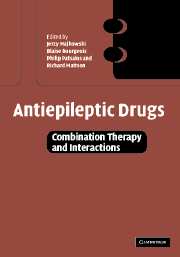Book contents
- Frontmatter
- Contents
- List of contributors
- Foreword
- Foreword
- Acknowledgements
- Part I Introduction
- Part II Pharmacokinetic interactions
- 4 Pharmacokinetic principles and mechanisms of drug interactions
- 5 Predictability of metabolic antiepileptic drug interactions
- 6 Influence of food and drugs on the bioavailability of antiepileptic drugs
- 7 Interactions between antiepileptic drugs
- 8 Interactions between antiepileptic and non-antiepileptic drugs
- Part III Pharmacodynamic interactions
- Part IV Drug interactions in specific patient populations and special conditions
- Part V Conclusions and future perspectives
- Index
6 - Influence of food and drugs on the bioavailability of antiepileptic drugs
from Part II - Pharmacokinetic interactions
Published online by Cambridge University Press: 07 September 2009
- Frontmatter
- Contents
- List of contributors
- Foreword
- Foreword
- Acknowledgements
- Part I Introduction
- Part II Pharmacokinetic interactions
- 4 Pharmacokinetic principles and mechanisms of drug interactions
- 5 Predictability of metabolic antiepileptic drug interactions
- 6 Influence of food and drugs on the bioavailability of antiepileptic drugs
- 7 Interactions between antiepileptic drugs
- 8 Interactions between antiepileptic and non-antiepileptic drugs
- Part III Pharmacodynamic interactions
- Part IV Drug interactions in specific patient populations and special conditions
- Part V Conclusions and future perspectives
- Index
Summary
Introduction
Whenever two or more agents are used in combination the potential for interactions can occur. These interactions can occur at the pharmacodynamic and/or pharmacokinetic level. Pharmacokinetic interactions are by far the most frequent and result in the modification of blood or tissue drug concentration as a consequence of alterations in absorption, distribution, metabolism, or elimination of a drug.
Drugs with a narrow therapeutic range or low therapeutic index are more likely to be associated with clinically important interactions. As far as antiepileptic drugs (AEDs) are concerned, they may interact with each other when used in combination therapy, and with other non-epilepsy-related drugs or with over-the-counter medications. Furthermore, food and many excipient components of pharmaceutical formulations may also interact with AEDs. This chapter deals with interactions which occur before (pharmaceutical interactions) and during (pharmacokinetic interactions) absorption.
General principles
Since many AEDs are sparingly soluble in aqueous solutions, they are sensitive to any effects that alter solubility, dissolution, or gastrointestinal motility. The delivery of drugs into the circulation may be altered by physicochemical interactions that occur prior to absorption. For example, drugs may interact in an intravenous solution to produce an insoluble precipitate or may be damaged by light (Figueiredo et al., 1993). Moreover, in the gut, drugs may chelate with metal ions or adsorb to resins. Thus the absorption of a particular drug is profoundly influenced by a great number of factors, which can be classified as follows:
(a) chemical characteristics and formulation,
(b) food and fluid intake,
(c) disease states,
(d) interaction with other drugs.
Keywords
- Type
- Chapter
- Information
- Antiepileptic DrugsCombination Therapy and Interactions, pp. 93 - 110Publisher: Cambridge University PressPrint publication year: 2005
- 2
- Cited by



